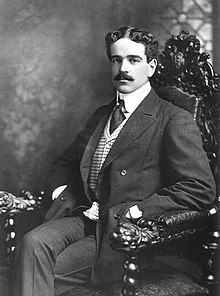William Kissam Vanderbilt II
William Kissam Vanderbilt II | |
|---|---|
 Vanderbilt photographed by Theodore C. Marceau, 1903 | |
| Born | October 26, 1878 New York City, US |
| Died | January 8, 1944 (aged 65) New York City, US |
| Burial place | Vanderbilt Family Cemetery and Mausoleum, Staten Island, New York, U.S. |
| Education | St. Mark's School Harvard University |
| Spouses | |
| Children | 3, including Muriel Vanderbilt |
| Parent(s) | William Kissam Vanderbilt Alva Erskine Smith |
William Kissam Vanderbilt II (October 26, 1878 – January 8, 1944) was an American
Early life
He was born on October 26, 1878, in New York City,[1] the second child and first son of William Kissam Vanderbilt and Alva Erskine Smith. His maternal grandfather was Murray Forbes Smith. Known as Willie K., he was a brother to Harold Stirling Vanderbilt and Consuelo Vanderbilt. Born to a life of luxury, he was raised in Vanderbilt mansions, traveled to Europe frequently, and sailed the globe on yachts owned by his father.
Willie was educated by tutors and at St. Mark's School. He attended Harvard University but dropped out after two years.
Career
While a great part of his life was filled with travel and leisure activities, Willie's father put him to work at the family's New York Central Railroad offices at Grand Central Terminal in Manhattan. As such, in 1905 he joined other Vanderbilts on Fifth Avenue, building the William K. Vanderbilt House at 660 Fifth Avenue.
Already extremely wealthy from a trust fund and from his income as president of the New York Central Railroad Company, on his father's death in 1920 Willie inherited a multimillion-dollar fortune.
Military service
On May 9, 1917, Vanderbilt went into active service in the Navy as a lieutenant (junior grade) in command of
After the war, Vanderbilt was promoted to the rank of lieutenant commander in the Naval Reserve on May 17, 1921.[3] He remained in the Naval Reserve until he was transferred to the Honorary Retired List on January 1, 1941, for physical disability.[4]
Life as an heir
Although he developed an interest in
.A skilled sailor, he participated in

The Vanderbilt Cup auto races repeatedly had crowd control problems and at the 1906 race a spectator was killed. Seeing the potential to solve the safety issue as well as improve attendance to his race, Willie formed a corporation to build the
His new high-speed road complemented a train service that allowed a rapid exit from Manhattan. Becoming the first suburban automobile commuter, in 1910 Willie began work on the much more elaborate and costly "
Residences
In 1925, he traded the luxury yacht Eagle for ownership of
Personal life
In 1899, Vanderbilt married
- Frederic Cameron Church, Jr.She later married Henry Delafield Phelps and John Payson Adams.
- Consuelo Vanderbilt (1903–2011), who married Noble Clarkson Earl (1900–1969)
- William Kissam Vanderbilt III (1907–1933), who inherited his father's love of fast cars and exotic travel, was killed in an automobile accident in South Carolina while driving home to New York City from his father's Florida estate.
The Vanderbilts separated after ten years of marriage but did not formally divorce until 1927 when he wanted to remarry. Divorce proceedings were handled by his New York lawyers while he and
Vanderbilt died on January 8, 1944, of a heart ailment.
Legacy
In 1931, Vanderbilt had the Krupp
By the 1940s, Vanderbilt had organized his will so that, upon his death, the Eagle's Nest property along with a $2 million upkeep fund would be given to Suffolk County, New York, to serve as a public museum. Since 1950, the site has operated as the Suffolk County Vanderbilt Museum.[13]
References
- ISBN 9780786458233. Retrieved March 4, 2022.
- ^ Harvard's Military Record in the World War. pg. 983.
- ^ Register of Commissioned Officers of the U.S. Naval Reserve. July 1, 1939. pg. 3.
- ^ Register of Commissioned Officers of the U.S. Naval Reserve. July 1, 1941. pg. 488.
- ^ "History of the Vanderbilt Museum | Historic Mansion Long Island".
- ^ "Exhibit Opens: Artist-Curator William Belanske". October 24, 2015.
- ^ Fisher, Lionel L. Fisher Island. Fisher Island, FL: Island Developers, 1994. p. 18.
- ISBN 0-926494-09-0. p. 196.
- ^ "At Long Island's Historic Vanderbilt Mansion, Eagle's Nest". Untapped New York.
- ^ "W. K. VANDERBILT DIES IN HOME HERE; Founder of the Vanderbilt Cup. Races -- Former President of New York Central". The New York Times. January 8, 1944. Retrieved August 30, 2017.
- ^ "William Kissam Vanderbilt". Associated Press. January 8, 1944. Retrieved May 23, 2011.
- ^ "W. K. Vanderbilt Dies In N. Y. Of Heart Disease". Chicago Tribune. January 8, 1944. Retrieved May 27, 2011.
- ^ "History of the Vanderbilt Museum | Historic Mansion Long Island".
External links
- William K. Vanderbilt Jr. (VanderbiltCupRaces.com)
